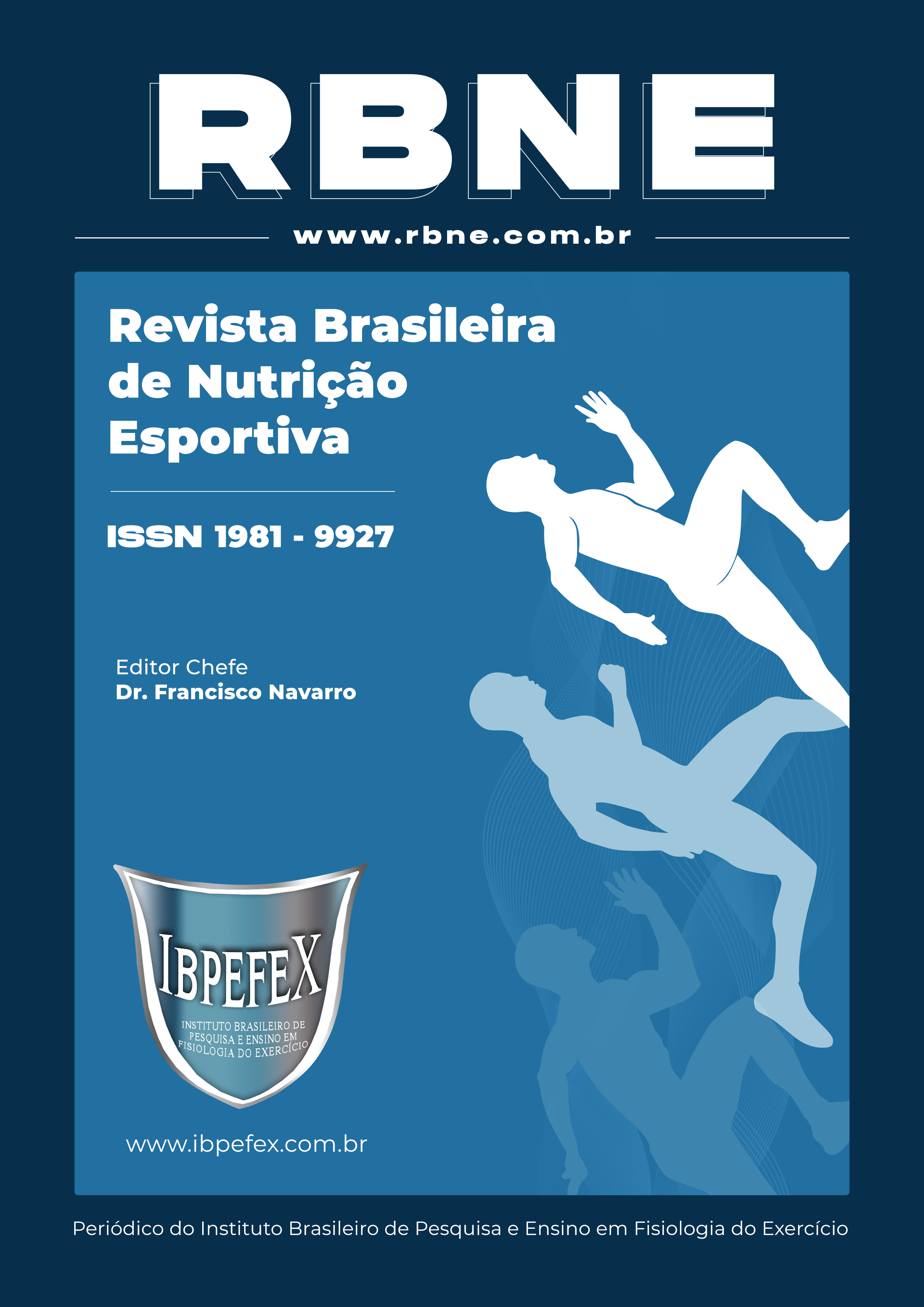Food profile associated with the nutritional status of Crossfit® practitioners
Abstract
Crossfit® is a training modality that has more fans every year, making a search for better nutrition for a good performance and obtaining quality results. Thus, the aim of this study is to assess the nutritional status and dietary profile of practitioners of this modality. Therefore, a quantitative, transversal, descriptive research was carried out, with 24 individuals of both sexes, aged between 18 and 52 years. Anthropometric assessment was performed to identify weight, height, circumferences, and fat percentage through skinfolds. The results indicate high levels of body fat; however, the participants have a relatively healthy diet, demonstrating that they are looking for a more adequate consumption. Therefore, it is concluded that it is necessary for the participants to seek follow-up with a nutritionist for guidance on eating habits.
References
-Blackburn, G. L.; Thornton, P. A. Nutritional assessment of the hospitalized patient. Medical Clinics of North America. Philadelphia. Vol. 63. Num. 5. 1979. p. 11103-11115.
-Brasil. Ministério da Saúde. Secretaria de Atenção à Saúde. Departamento de Atenção Básica. Guia Alimentar para a População Brasileira. 2ª edição. Brasília. 2014.
-Brescansin, B. M; Naziazeno, R. F. T; Miranda, T. V. Análise do perfil alimentar de praticantes de Crossfit® na região de Belém do Pará. Revista Brasileira de Nutrição Esportiva. São Paulo. Vol. 13. Num. 81. 2019. p. 830-838.
-Bueno, B. A; Ribas, M. R; Bassan, J. C. Determinação da ingestão de micro e macro nutrientes na dieta de praticantes de Crossfit®. Revista Brasileira de Nutrição Esportiva. São Paulo. Vol. 10. Num. 59. 2016. p. 579-586.
-Claudino, J. G.; Gabbett, T. J.; Bourgeois, F.; Souza, H. S.; Miranda, R. C.; Mezêncio, B.; Soncin, R.; Cardoso Filho, C. A.; Bottaro, M.; Hernandez, A. J.; Amadio, A. C.; Serrão, J. C. Crossfit® overview: systematic review and meta-analysis. Sports Medicine - Open. New York. Vol. 4. Num. 1. 2018. p. 1-14.
-Dominski, F. H.; Casagrande, P. O.; Andrade, A. O fenômeno CrossFit®: análise sobre o número de boxes no Brasil e no mundo e modelo de treinamento e competição. Revista Brasileira de Prescrição e Fisiologia do Exercício. São Paulo. Vol. 13. Num. 82. 2019. p. 271-28.
-Giacomelli, K. B.; Santos, P. R.; Nepomuceno, P.; Barros, A. Efeitos do consumo de álcool no desempenho e recuperação do exercício físico. Revista Brasileira de Nutrição Esportiva. São Paulo. Vol. 13. Num. 82. 2019. p. 1009-1016.
-Gogojewicz, A.; Śliwicka, E.; Durkalec-Michalski, K. Assessment of dietary intake and nutritional status in Crossfit®-trained individuals: A descriptive study. International Journal of Environmental Research and Public Health. Basel. Vol. 17. Num. 13. 2020. p. 4772.
-Heyward, V. H.; Stolarczyk, L. M. Avaliação da composição corporal aplicada: fundamentos da composição corporal. São Paulo. Manole. 2000. p. 243.
-Lacerda, R. M. C. P.; Tavares, R. L. Efeito de uma dieta restritiva em praticantes de Crossfit®. Revista Campo do Saber. Cabedelo. Vol. 3. Num. 2. 2020. p. 152-166.
-Lins, T. C. L.; Souza, L. P. V. Dieta pré e pós-treino em praticantes de Crossfit®: um perfil qualitativo do consumo de alimentos e suplementos. Revista Brasileira de Nutrição Esportiva. São Paulo. Vol. 13. Num. 82. 2019. p. 946-953.
-Oliveira, C. E.; Sandoval, T. C.; Silva, J. C. S.; Stulbach, T. E.; Frade, R. E. T. Avaliação do consumo alimentar antes da prática de atividade física de frequentadores de uma academia no município de São Paulo em diferentes modalidades. Revista Brasileira de Nutrição Esportiva. São Paulo. Vol. 7. Num. 37. 2013. p. 57-67.
-Organista, C. A. M. CrossFit®: benefícios e métodos da prática vs treinamento resistido tradicional: uma breve revisão. TCC. Universidade Regional Integrada do Alto Uruguai e das Missões. Erechim. Rio Grande do Sul. 2018.
-Pollock, M.L.; Wilmore, J.H. Exercício na saúde e na doença: Avaliação e prescrição para prevenção e avaliação. Rio de Janeiro. Medsi. 1993. p. 718.
-Porto, T. N. R. S.; Cardoso, C. L. R.; Baldoino, L. S.; Martins, V. S.; Alcântara, S. M. L.; Carvalho, D. P. Prevalência do excesso de peso e fatores de risco para obesidade em adultos. Revista Eletrônica Acervo Saúde. Vol. 22. 2019. p. e308.
-Rendeiro, L. C.; Ferreira, C. R.; Souza, A. A. R.; Oliveira, D. A.; Della Noce, R. R. Consumo alimentar e adequação nutricional de adultos com obesidade. Revista Brasileira de Obesidade, Nutrição e Emagrecimento. São Paulo. Vol. 12. Num. 76. 2018. p. 996-1008.
-Santos, H. V. D.; Araújo, I. S. Impacto do aporte protéico e do estado nutricional no desfecho clínico de pacientes críticos. Revista Brasileira de Terapia Intensiva. São Paulo. Vol. 31. Num. 2. 2019. p. 210-216.
-Tibana, R. A.; Almeida, L. M.; Prestes, J. Crossfit® riscos ou benefícios? O que sabemos até o momento. Revista Brasileira de Ciência e Movimento. Vol. 23. Num. 1. 2015. p. 182-185.
Copyright (c) 2022 Maria Helena Soares de Mesquita, Danilo Ramos Cavalcanti

This work is licensed under a Creative Commons Attribution-NonCommercial 4.0 International License.
Authors who publish in this journal agree to the following terms:
- Authors retain the copyright and grant the journal the right of first publication, with work simultaneously licensed under the Creative Commons Attribution License BY-NC which allows the sharing of the work with acknowledgment of the authorship of the work and initial publication in this journal.
- Authors are authorized to enter into additional contracts separately for non-exclusive distribution of the version of the work published in this journal (eg, publishing in institutional repository or book chapter), with acknowledgment of authorship and initial publication in this journal.
- Authors are allowed and encouraged to post and distribute their work online (eg, in institutional repositories or on their personal page) at any point before or during the editorial process, as this can bring about productive change as well as increase impact and impact. citation of published work (See The Effect of Free Access).






